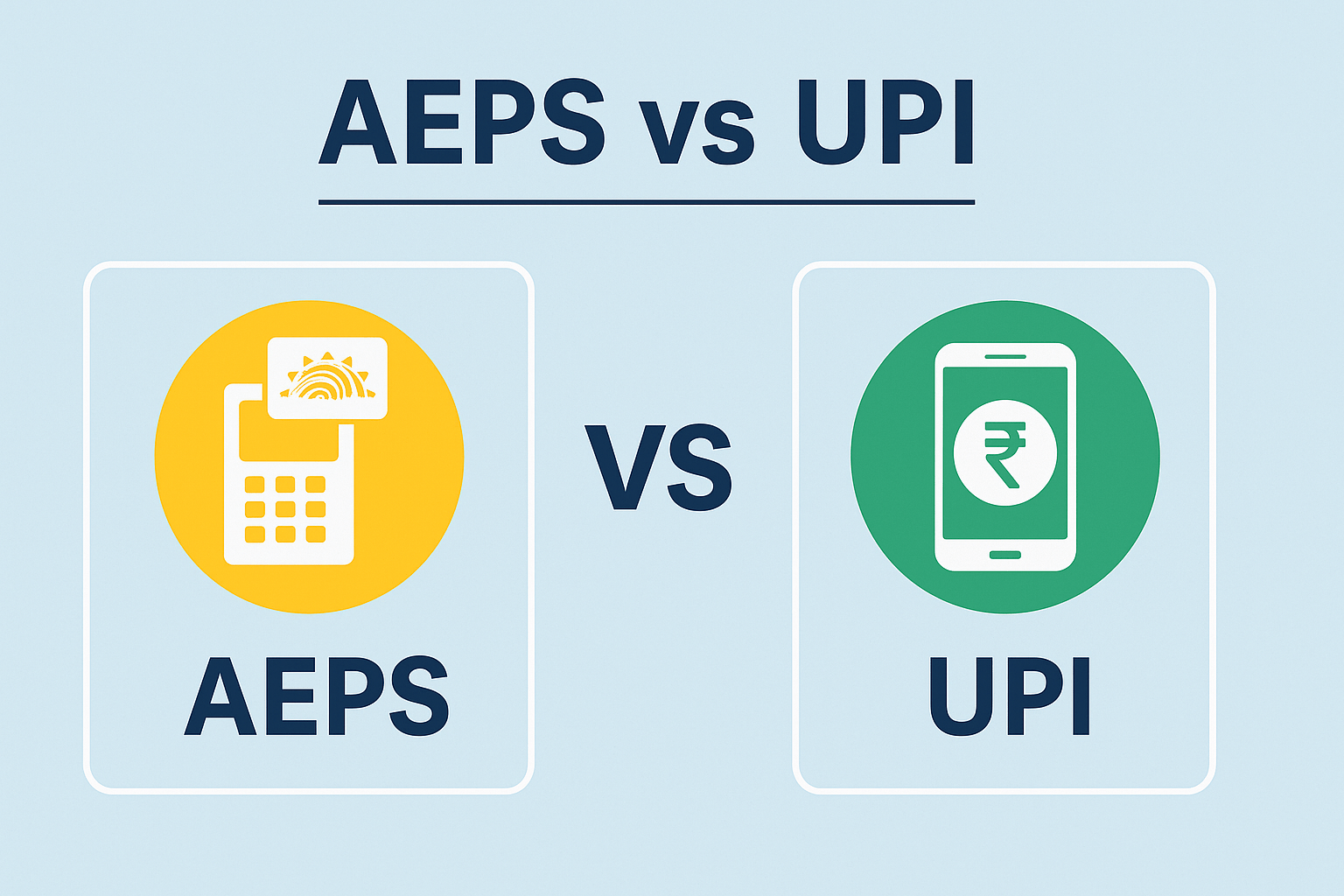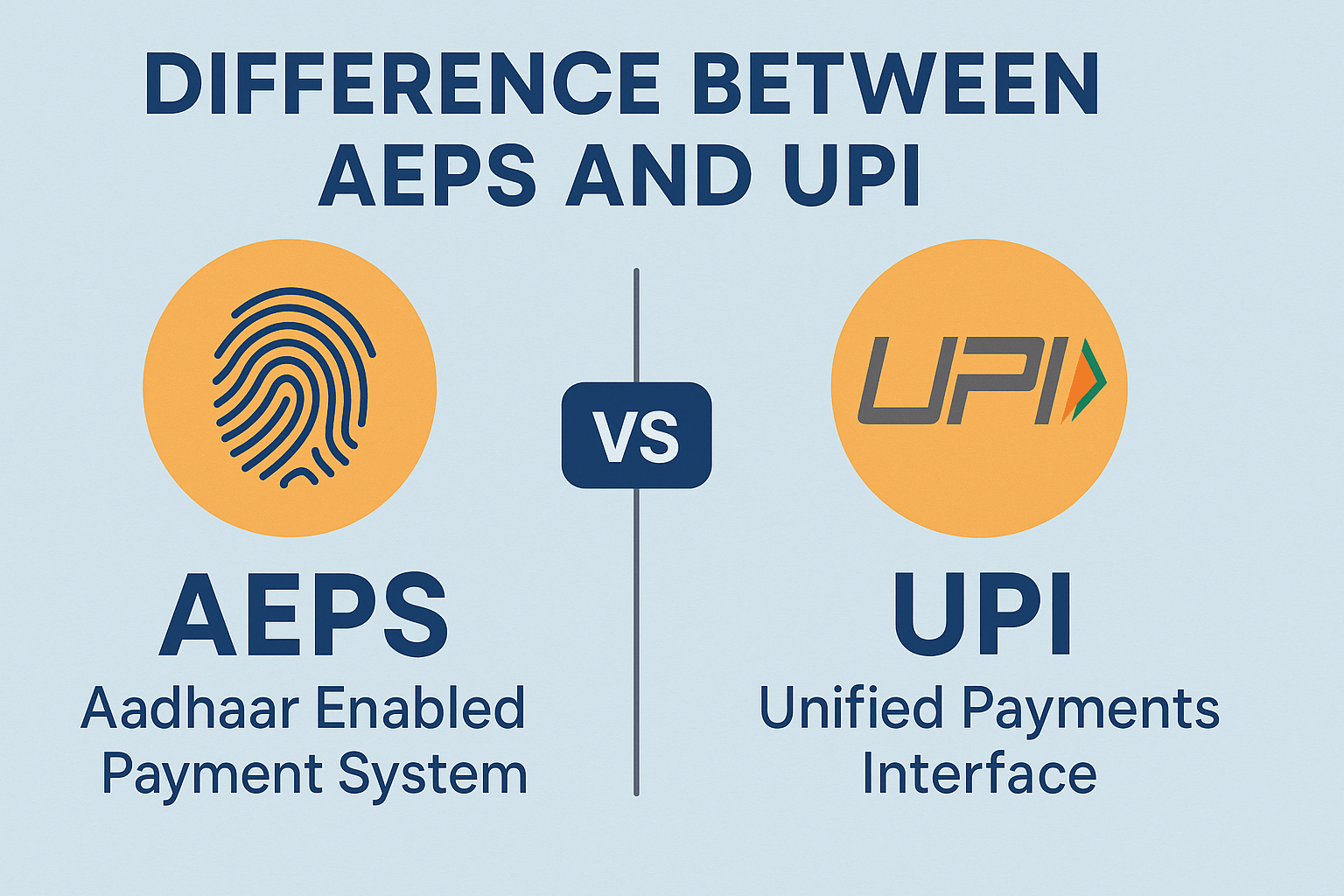In the bustling digital economy of India, two (AEPS vs. UPI) acronyms have fundamentally changed how we transact: AEPS and UPI. While you might use UPI every day to split a bill or pay the local kirana store, you might have only heard of AEPS in passing. Both are revolutionary, but they serve vastly different purposes and audiences. So, which one is better? The answer isn’t straightforward, as it depends entirely on context. This in-depth guide will break down the difference between AEPS and UPI, exploring their unique strengths, target users, and ultimately help you understand which one is “better” for a specific need.
https://example.com/image-aeps-vs-upi.jpg
Alt Text: Difference between AEPS and UPI in the Indian digital payment landscape
Understanding the Foundations: What Are AEPS and UPI?
Before we pit them against each other, let’s establish what each system is designed to do.
What is AEPS (Aadhaar Enabled Payment System)?
AEPS is a bank-led model that allows you to perform basic banking transactions using only your Aadhaar number and biometric authentication (fingerprint or iris scan). Developed by the National Payments Corporation of India (NPCI), its primary goal is financial inclusion. It enables individuals without access to debit cards, smartphones, or even the ability to remember complex PINs to access their bank accounts.
How AEPS Works:
-
You visit an AEPS-enabled micro-ATM or a Business Correspondent (BC—a bank representative in a local shop).
-
You provide your Aadhaar number and select your bank name.
-
You authenticate the transaction using your fingerprint on a biometric scanner.
-
The system verifies your identity with the UIDAI and your bank, processing the transaction instantly.
Key Services: Cash withdrawal, Cash deposit, Balance inquiry, Fund transfers (Aadhaar-to-Aadhaar).
What is UPI (Unified Payments Interface)?
UPI is a smartphone-based, real-time payment system that facilitates inter-bank transactions. It merges several bank accounts into a single mobile application, allowing for seamless money routing and merchant payments. UPI’s genius lies in its simplicity and versatility, using Virtual Payment Addresses (VPAs like yourname@bank) to avoid sharing sensitive bank details.
How UPI Works:
-
You use a UPI app (e.g., PhonePe, Google Pay, Paytm, or your bank’s app).
-
To send money, you enter the recipient’s VPA, scan a QR code, or select a contact.
-
You authenticate the transaction using a UPI PIN (a self-set 4- or 6-digit number).
-
The transaction is processed in real-time, 24/7.
Key Services: Instant money transfers (person-to-person, person-to-merchant), bill payments, recharges, investing, and more.

Head-to-Head: The Key Differences Between AEPS and UPI
Let’s break down their differences across several critical parameters.
| Feature | AEPS (Aadhaar Enabled Payment System) | UPI (Unified Payments Interface) |
|---|---|---|
| Primary Goal | Financial Inclusion | Digital Convenience & Cashless Economy |
| Technology | Biometric Authentication (Fingerprint/Iris) | Smartphone App & UPI PIN |
| Infrastructure Needed | Micro-ATM, Biometric Scanner, Internet | Smartphone, Internet Connection |
| User Requirement | Aadhaar Number, Bank Account linked to Aadhaar | Smartphone, Bank Account, Debit Card (for PIN set-up) |
| Key Transactions | Cash Withdrawal, Deposit, Balance Check | Funds Transfer, Merchant Payments, Bill Pay |
| Interoperability | Limited to banking services at BC points | Highly interoperable across all banks and apps |
| Security | Biometric data (highly secure, difficult to forge) | UPI PIN & App-based security (2FA) |
| Accessibility | Excellent for rural, elderly, non-tech-savvy users | Excellent for urban, tech-savvy smartphone users |
Which One is Better? It Depends on the Use Case.
Declaring one system “better” than the other is like saying a tractor is better than a sports car. It entirely depends on the terrain you’re driving on.
When is AEPS the Better Choice?
AEPS is not just “better” but essential for a significant segment of the Indian population.
-
For the Unbanked and Underbanked: For millions in rural India or daily wage workers without smartphones, AEPS is a lifeline. It brings the bank to their doorstep through Business Correspondents.
-
Cash-Based Transactions: In an economy that still runs significantly on cash, AEPS provides a secure and authorized channel for withdrawing and depositing physical money digitally.
-
For the Elderly or Technophobic: Individuals uncomfortable with apps and passwords find the simplicity of using their fingerprint incredibly empowering.
-
During Network Issues: In areas with poor mobile data connectivity, a BC’s stable internet connection can be more reliable for transactions.
Expert Insight: A report by NPCI highlights that AEPS has been instrumental in driving the government’s Direct Benefit Transfer (DBT) scheme, ensuring subsidies reach the intended beneficiary directly without leakage.
When is UPI the Better Choice?
UPI is the undisputed champion for the digitally literate population seeking speed and convenience.
-
For Everyday Digital Payments: From buying groceries to paying for an auto-rickshaw, UPI’s QR code is ubiquitous and offers unmatched convenience.
-
Peer-to-Peer (P2P) Transfers: Splitting rent, sending money to family, or paying your friend back for coffee is instantaneous with UPI.
-
24/7 Availability: Unlike a BC outlet that has operating hours, UPI works anytime, anywhere.
-
Rich Feature Set: UPI is far more than just transfers. It’s a platform for paying utilities, investing in stocks, buying insurance, and more.
Statistic: According to the Reserve Bank of India (RBI), UPI processed over 11.4 billion transactions in March 2024 alone, showcasing its massive adoption and scale.

The Verdict: Complementary, Not Competitive
The question of which one is better, AEPS or UPI? reveals a false dichotomy. They are not rivals; they are complementary systems working in tandem to achieve a larger goal: bringing every Indian into the fold of formal finance.
-
AEPS lays the groundwork by onboarding the last mile of the population into the banking system. It handles the critical “first touch” and facilitates cash-in, cash-out operations, which are still a reality for millions.
-
UPI builds on that foundation by offering a sophisticated, feature-rich platform for a cash-lite economy. It is the natural progression for someone who started their financial journey with AEPS.
Think of AEPS as the foundation of a house—absolutely critical for structural integrity. UPI is the beautiful, functional living space built on top of that foundation. One cannot function to its full potential without the other in a country as diverse as India.
### Frequently Asked Questions (FAQs)
1. Can I use UPI without a debit card?
Yes, but only for certain transactions. Some UPI apps now allow small-value transactions without a debit card for PIN creation using the “UPI Lite” feature. However, for standard transactions and higher limits, a debit card is still required to set up your UPI PIN initially.
2. Is AEPS completely safe?
Yes, it is highly secure. Your biometric data is not stored on any local device; it is encrypted and sent to UIDAI for authentication. It is nearly impossible to forge or replicate, making it one of the most secure authentication methods.
3. Which has lower charges, AEPS or UPI?
For end-users, both are currently free for most transactions. Banks and service providers may bear minimal processing costs. The government and RBI have actively promoted zero-charge models to encourage adoption.
4. Can I use AEPS on my phone?
A smartphone alone is not enough. While the AePS NFBC app exists for Business Correspondents, it requires a specific, registered biometric device connected to the phone to work. It is not a typical consumer-facing app like PhonePe or Google Pay.
5. What is the future of these systems?
The future is convergence. We are already seeing innovations like UPI 123Pay for feature phones, which aims to bridge the gap between AEPS’s target audience and UPI’s functionality. The lines will continue to blur, making digital payments accessible to all.
Disclaimer: This article is for educational and informational purposes only. The views expressed are based on research and analysis of publicly available information. While every effort has been made to ensure accuracy, the dynamic nature of digital payments means that features and policies may change. For specific financial advice, please consult with a qualified professional. If you have any concerns regarding the content of this post, including issues of ownership or copyright (DMCA), please contact us through the appropriate channels outlined on our DMCA policy page for a prompt resolution.
